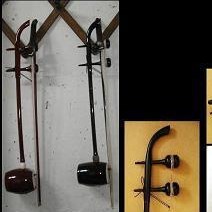Four-stringed xiqin overview
 Sixian Xiqin (Pinyin: sì xián xī qín) (Reform Xiqin·Sixian Xiqin) is a Korean bow-drawn stringed musical instrument. In the 1960s, the Korean Xiqin performer Li Yinan and others successfully produced the reformed Xiqin and the four-string Xiqin, which have been used in professional music and art groups in Yanbian Korean Autonomous Prefecture, Jilin Province.
Sixian Xiqin (Pinyin: sì xián xī qín) (Reform Xiqin·Sixian Xiqin) is a Korean bow-drawn stringed musical instrument. In the 1960s, the Korean Xiqin performer Li Yinan and others successfully produced the reformed Xiqin and the four-string Xiqin, which have been used in professional music and art groups in Yanbian Korean Autonomous Prefecture, Jilin Province.Four-stringed xiqin is a new type of Xiqin series of musical instruments. It includes three types of high-pitched, alto and bass Xiqin. It is most suitable for ensemble or accompaniment and has been used in Korean national bands.
The musical instruments of Xiqin are not only popular among Korean folk, but also popular among Mongolian folks in eastern Inner Mongolia Autonomous Region, Liaoning, Heilongjiang and other provinces. Its structure and playing method are similar to the Korean Xiqin, but the shape is smaller. The piano bar is made of colored wood or hard miscellaneous wood and is 50 cm long. The qin barrel is made of wood or metal, the barrel is 10 cm long, and the front mouth is covered with a paulownia veneer with a diameter of 7 cm. The pegs are wooden, conical. Zhang two silk or casing strings. The bow is made of bamboo, bent into an arc, with ponytails tied at both ends, and the length of the bow is 40 cm. The fifth tuning is g, d1, the range is g-g1, and there is only one octave. The pronunciation is soft and the tone is rich. However, it is not widely spread, and only a few old folk artists still use it.
- Chinese name:Four-stringed xiqin
- full length:65 cm
- Kind of musical instrument:bowed stringed musical instrument
- Pinyin:sì xián xī qín
overview of other similar instruments
- sanyanxiao overview
- Daguangxian overview
- Leiqin overview
- hahao overview
- yandundagu overview
- Han Xiaozheng overview
- Fang Xiang overview
- guanzi overview
- zhuqin (Dao Qin) overview
- zhuiqin overview
- bangzi overview
- three-stringed piano overview
- Gehu overview
- xiao overview
- xiaokonghou overview
- Konghou overview
- Sheng overview
- suona overview
- hulusi overview
- gushao overview
 渝公网安备 50010702504639号
渝公网安备 50010702504639号